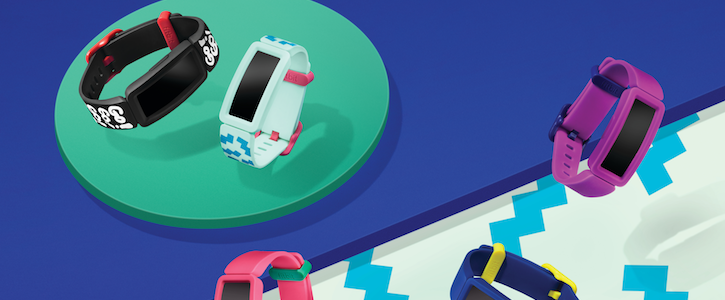Why Fitbit Is Placing Heavy Emphasis on Its Platform
The wearables company already boasts more than 27 million users — and it hopes new low-cost devices will scoop up more.

Versions of the Fitbit Ace 2. Image has been altered. Courtesy of Fitbit.
Fitbit may be best known as a company that makes devices, but even as it expands its line of fitness tech, the company sees its platform as the key to ensuring wearable technology translates into better health for users.
Fitbit last month unveiled four new wearables, three of which will retail for $100 or less. They include the Inspire HR, a wearable that offers continuous heart rate monitoring, and its $70-dollar counterpart without the heart rate feature. The Fitbit Ace 2 also sells for around $70 and is designed to help children 6 years and older track their fitness. The most expensive of the new line is the Versa Lite, which at $159.95 is Fitbit’s most inexpensive smartwatch.
But it’s not all about the hardware. James Park, Fitbit’s co-founder and CEO, said in a press release that the company expects the new devices to drive more people into Fitbit’s user base.
“Bringing more users to the wearables category and growing our community of active users is a critical part of our strategy,” he said. “We will continue to build on the Fitbit platform to provide a more personalized and valuable experience for our users through a paid premium service expected to launch later this year.”
That platform now boasts more than 27.6 million people, and the company has been working hard to keep those users engaged and focused on their health goals.
“Being on Fitbit is not just about the device,” a company spokesperson told Inside Digital Health™ in a follow-up email. “We offer an engaging platform experience of software, social and app features that can impact behavior change and help users reach their health and fitness goals.”
Data provided by the company suggests that nearly three-quarters (73 percent) of Fitbit users who enter a weight-loss goal into the tracker lose weight, and 70 percent of low-activity users increased their movement when they used the platform’s “Reminders to Move” notifications.
In addition to the premium service Park teased, the company is also launching a redesigned app and a new rewards program.
The company has launched Fitbit Care, a platform for employers and health plans through which participants can get personalized coaching and personalized digital health interventions. The Fitbit Plus app allows for the integration of a wider array of health tracking, such as blood glucose monitoring and blood pressure, in coordination with other connected devices. That data can be shared with physicians and health coaches to provide a more holistic understanding of the patient’s healthcare between visits.
Of course, having the data available is only valuable if the information reaches physicians. The company told Inside Digital Health™ that doctors are becoming more aware of the potential of data from wearables.
“We’ve started to see a shift in how physicians, health systems and hospitals are viewing the patient-generated health data that can come from wearable devices,” the company said in its statement.
A recent survey of hospital administrators and healthcare providers conducted by Fitbit and HIMSS suggested 79 percent of respondents would like to have more data about patients, and 72 percent said they need patient health data to make good decisions when it comes to chronic health management.
When survey respondents were asked about their top reasons for incorporating wearables into patient care, the respondents most often cited the ability to make timely interventions, provide immediate feedback and boost patient accountability and empowerment.
“All of these reasons for incorporating wearables point to the great potential they have for impacting the economics of healthcare and the well-being of populations,” the Fitbit spokesperson said.
Get the best insights in digital health directly to your inbox.
Related
Fitbit and NIH Launch Digital Health Tech Initiative for All of Us Program
Wearables Are Saving Human Lives. Can They Save Hospitals Too?
Fitbit Shows Promise in Tracking Performance, Predicting Cancer Outcomes